

Intercropping dryland rice with spinach and turnip did not improve land use efficiency or reduce weed pressure.
Sustainable Agriculture Student Research Project
Intercropping Dryland Rice and Greens for Weed SuppressionNhi Nguyen, Department of Sustainable Agriculture, 2023 |
Introduction
Rice is one of the staple crops for more than half the world’s population. It is mostly grown in Asia, with 90% of global production (Childs 2022).
Most traditional rice fields are flooded to suppress weed emergence. Flooding requires a huge amount of water and creates anaerobic conditions that accelerate the emission of methane (CH4) into the atmosphere. Methane is estimated to be 27-30 times more potent than carbon dioxide over 100 years in causing global warming (United States Environmental Protection Agency (EPA) 2022).
An alternative to this traditional system is dryland rice cultivation (or upland rice), in which rice is grown in unflooded soil. The main constraint of upland rice is high weed pressure due to the absence of water.
Intercropping could be a more sustainable weed management strategy than flooding. Wheat-legume intercropping reduced weed biomass by 90% when suitable intercrops were chosen (Leoni et al. 2022).
This experiment was conducted to evaluate the effect of intercropping dryland rice with spinach and turnip on rice yield and weed suppression.
Methods
Location: KPU Farm, Garden City Lands, Richmond, British Columbia
A Randomized Complete Block Design was used to layout the plot with five replicates and three treatments:
- Rice monoculture
- Spinach and turnip monocultures in succession
- 1:1 mixture of rice and spinach/turnip succession
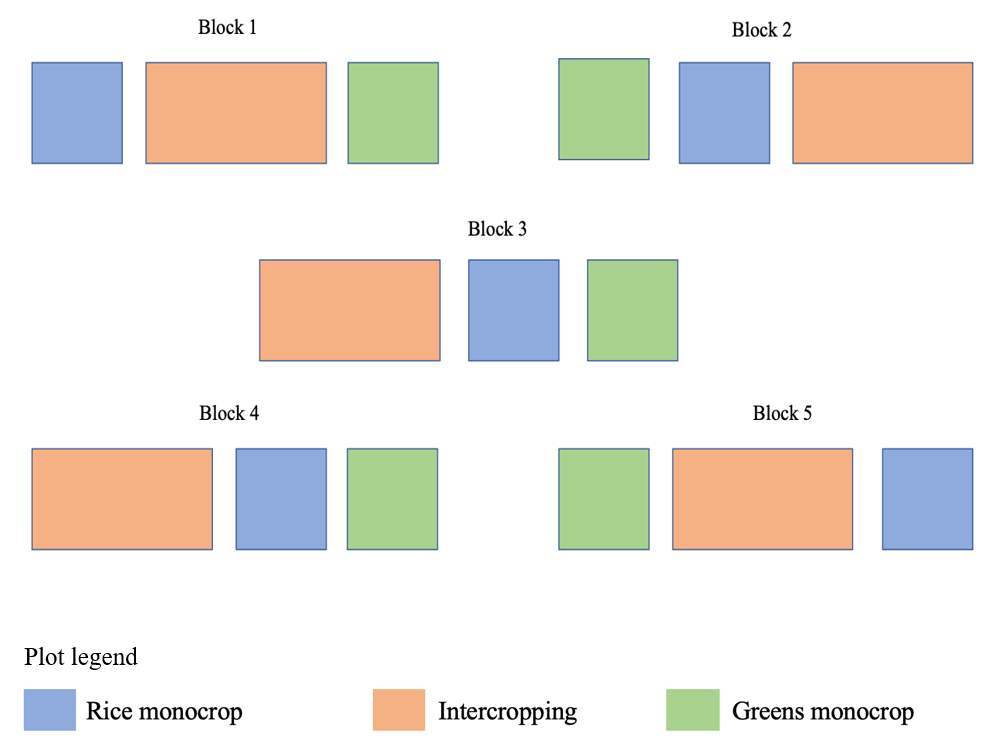
Figure 1. Plot layout of the rice intercropping study, using Randomized Complete Block Design
Plot preparation and maintenance:
- Each monoculture plot was 1.6 m x 1.6 m
- Each mixture plot was 2.6 m x 1.6 m
- 5 kg of blood meal was applied on June 2nd
- Drip irrigation was set up to moisten the soil before transplanting
- Three-week-old rice was transplanted on June 5th
- Two-week-old spinach was transplanted on June 5th
- The plot was covered with row covers during first three days after transplanting
- Turnip was direct seeded (3-4 seeds/hole) on July 7th, after spinach harvest
- All plots were hand weeded 1, 2 and 6 weeks after transplanting
- All crops were hand harvested
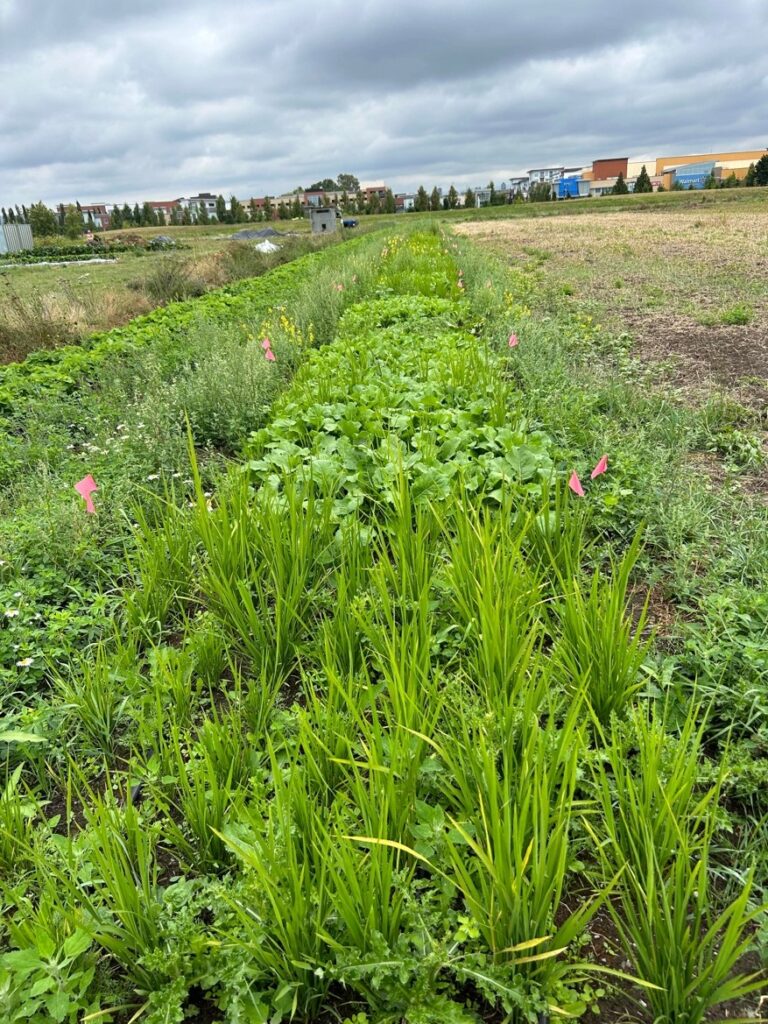
Figure 2. Rice intercropping research plots, with rice monoculture in the foreground, in front of a turnip monoculture and a rice / turnip mixture.
Data collection and analysis
Crops were harvested from 1 m2 in the center of each monoculture plot, and from 2 m2 in the center of each mixed plot, leaving a 30 cm buffer around the harvested area to reduce edge effects. Dry weight of rice grain was recorded after hand harvesting, drying threshing, and winnowing. Fresh weight of spinach and turnip was recorded at harvest.
Photographs were taken above each plot before and after weeding, and the amount of weed cover removed was calculated using the Canopeo application.
Land use efficiency was compared using the Land Equivalence Ratio (LER) and the Relative Land Output (RLO).
LER measures the relative land required for a monoculture to obtain the same yield as a mixture:

where Y is yield, in grams per square meter, of rice, spinach, or turnip mixtures or monocultures.
Relative land output (RLO) is calculated to evaluate any advantage to utilizing intercropping, relative to monocultures, on a given amount of land:

where Y is total output, in grams per plot, of rice, spinach, and turnip grown in a mixed plot or monoculture plots that sum to the same size as the mixed plot.
Both LER and RLO can be interpreted in the same way: If they are greater than 1, intercropping uses land more efficiently than monocropping; if they are less than 1, the monocultures are more efficient.
Weed cover data were analyzed using a mixed effects model:
- Fixed factors: Treatment and Weeks After Transplanting (WAT)
- Random factors: Block and plot
LER and RLO were compared to 1 using a one-sample Student’s t-test.
Crop yield was analyzed by ANOVA.
Results
Rice yield
No statistically significant difference in rice yield was found between monoculture and mixture system. However, on average, the yield of rice obtained from monoculture was ~61% higher, than from mixture, despite the fact that mixed plots were twice as large as monoculture plots (Figure 3).
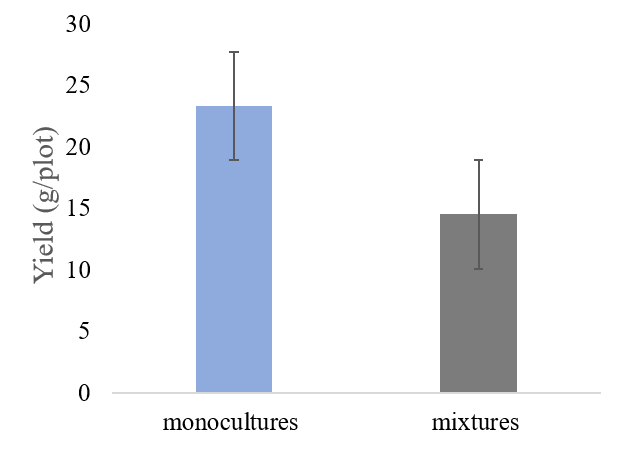
Figure 3. Rice output from pure stands (monocultures) and mixed plantings (mixtures). Mixed plots were twice as large as monoculture plots, so that an equivalent amount of space was dedicated to rice in each. Error bars denote standard deviation around mean.
Weed infestation
No significant treatment effect was found on weed cover (p = 0.189), but a significant interaction was detected between treatment and time after transplanting (Figure 4). Weed cover was lower in turnip monoculture than the rice-turnip mixture six weeks of transplanting (Figure 4). Weed cover increased over the course of the growing season (p < 0.001).
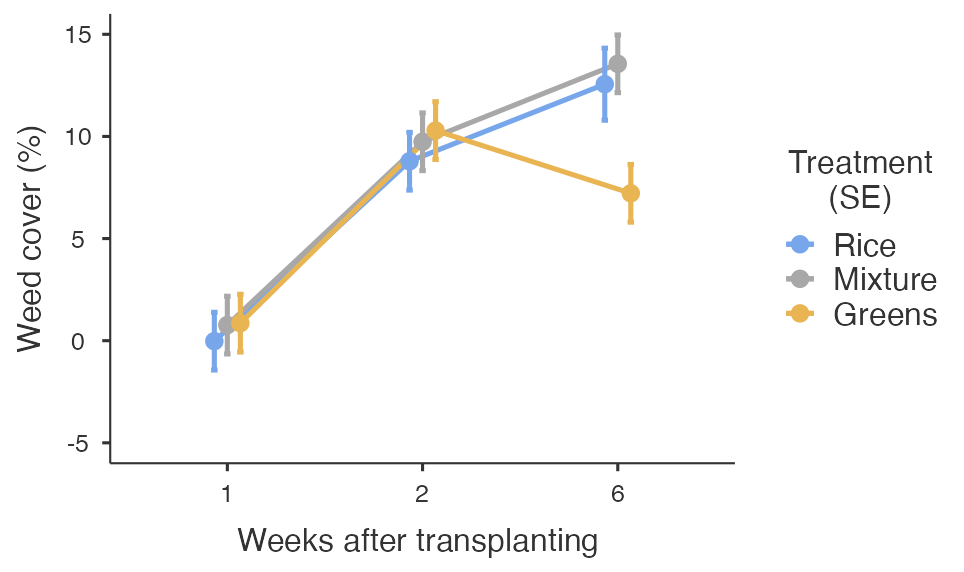
Figure 4. Weed cover removed by hand weeding 1, 2, and 6 weeks after transplanting rice. Error bars denote standard errors around mean.
Land use efficiency
Neither LER nor RLO was significantly different from 1, indicating no land use efficiency advantage to intercropping (Figure 5).
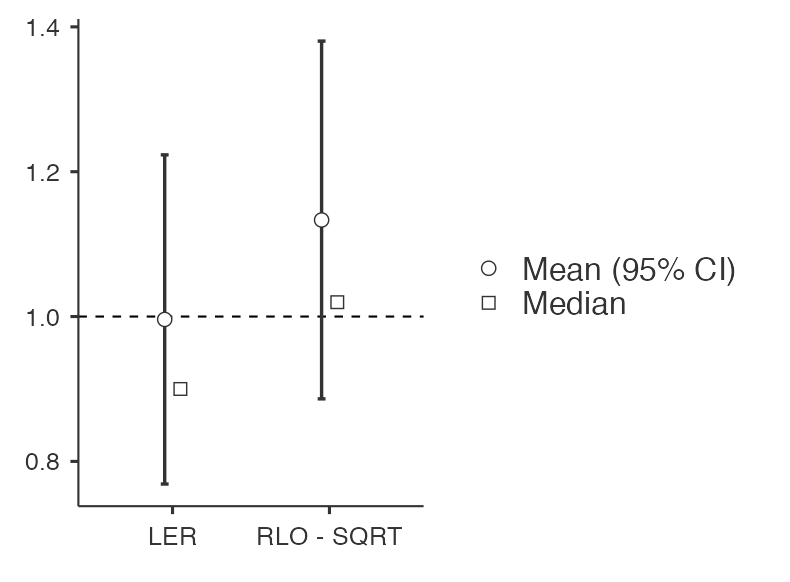
Figure 5. Mixture productivity relative to monocultures, according to the Land Equivalence Ratio (LER) and Square Root transformed Relative Land Output (RLO). Error bars denote 95% confidence interval. Dashed line shows value of one, where mixture and monoculture land use efficiency is equivalent.
Discussion
Land use efficiency
The study indicated that intercropping dry rice with spinach followed by turnip was as efficient as sole cropping. This might be attributed to the reduced rice yield in mixture plots. Rice monoculture plots produced 23.33 g/m2 compared to 14.52 g/m2 of rice produced in mixed plots.
A water deficit was observed early in the growing season, which could have negatively affected rice transplant establishment. Two weeks after transplanting the rice plants were weak and stunted, while spinach plants well established (Figure 6). Spinach plants may have gained a competitive edge over rice plants in mixed plots during this stage.

Figure 6. Rice and spinach plants two weeks after transplanting (June 20th).
Weed infestation
Weed pressure was lower in the turnip monocultures than in rice-turnip mixtures, which might be explained by the shading effect of turnip tops. Turnips emerged quickly and established well. Their tops shaded out and covered the ground, allowing them to compete successfully with weeds for light, space, and water.
Conclusion
Mixed planting of rice with spinach followed by turnip did not reduce weed infestation and did not offer higher land use efficiency than monocultures. Weed pressure was lower in turnip monocultures than in rice-turnip mixtures.
Acknowledgements
Thanks to Dr. Mike Bomford, Andy Smith, Sahar Zandieh, Masa Shiroki, Akio Nakamura, and KPU Farm staff for providing support and guidance throughout this experiment.
